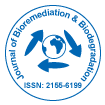Research Article
Stable Isotope Probing - A Tool for Assessing the Potential Activity and Stability of Hydrocarbonoclastic Communities in Contaminated Seawater
| Petra J Sheppard1*, Eric M Adetutu1, Alexandra Young2, Mike Manefield3, Paul D Morrison1 and Andrew S Ball1 | |
| 1RMIT University, School of Applied Science, Bundoora, Victoria 3083, Australia | |
| 2Flinders University, School of Biological Sciences, Bedford Park, SA, 5042, Australia | |
| 3Centre for Marine Bio innovation, University of New South Wales, Sydney, New South Wales, 2052, Australia | |
| Corresponding Author : | Petra J Sheppard RMIT University School of Applied Science, Bundoora Victoria 3083, Australia Tel: (61) 3 9925 6678 E-mail: Petra.Sheppard@rmit.edu.au |
| Received June 04, 2013; Accepted July 16, 2013; Published July 18, 2013 | |
| Citation: Sheppard PJ, Adetutu EM, Young A, Manefield M, Morrison PD, et al. (2013) Stable Isotope Probing - A Tool for Assessing the Potential Activity and Stability of Hydrocarbonoclastic Communities in Contaminated Seawater. J Bioremed Biodeg 4:192. doi:10.4172/2155-6199.1000192 | |
| Copyright: © 2013 Sheppard PJ, et al. This is an open-a ccess article distributed under the terms of the Creative Commons Attribution License, which permits unrestricted use, distribution, and reproduction in any medium, provided the original author and source are credited. | |
Related article at Pubmed Pubmed  Scholar Google Scholar Google |
|
Abstract
To optimize bioremediation strategies, knowledge of which bacterial groups are actually degrading specific hydrocarbon fractions is required. In this study, we monitored the utilization rate of unlabeled ( 12 C) and labeled ( 13 C) substrates, benzene (0.559 μL L -1 h -1 ) and hexadecane (0.330 μL L -1 h -1 ) in seawater pre-exposed to hydrocarbons over 72 h in laboratory based microcosms. Microbial community analysis by RNA-SIP DGGE showed substantial differences between the banding pattern of 12 C and 13 C communities. Cluster analysis of the microbial community profiles showed that the labeled bacterial population was ~25% similar to the original community in the unlabeled microcosms. This suggested that only a subset of the original bacterial community appeared to have utilized the labeled substrates. Sequence analysis of 16S rRNA gene sequences revealed the presence of known hydrocarbon degraders including Alcanivorax , Acinetobacter , Pseudomonas and Roseobacter . The presences of a number of Firmicutes in both sets of mesocosms suggest that these species were able to utilize both benzene and hexadecane. This study highlights the benefits of incorporating RNA-SIP in remediation studies to enhance the understanding of microbial communities in contaminated seawater.

 Spanish
Spanish  Chinese
Chinese  Russian
Russian  German
German  French
French  Japanese
Japanese  Portuguese
Portuguese  Hindi
Hindi 
